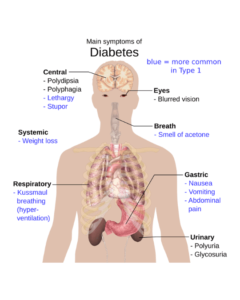Types of Diabetes Mellitus
-
Type 1 Diabetes
-
-
- An autoimmune disease where the immune system attacks and destroys insulin-producing cells in the pancreas.
- Primarily diagnosed in children and is typically congenital.
-
-
Type 2 Diabetes
-
-
- Occurs when the body does not produce enough insulin or when insulin receptors become less responsive, leading to insulin resistance.
- The most common type of diabetes.
-
-
Pre-diabetes
-
-
- A stage where blood glucose levels are higher than normal but not yet high enough to be diagnosed as type 2 diabetes.
-
-
Gestational Diabetes
-
-
- Develops during pregnancy and usually resolves after childbirth.
- Increases the risk of developing type 2 diabetes later in life.
-
-
Type 3c Diabetes
-
-
- Results from damage to the pancreas due to conditions such as pancreatitis, pancreatic cancer, cystic fibrosis, or hemochromatosis.
-
-
Latent Autoimmune Diabetes in Adults (LADA)
-
-
- A condition similar to type 1 diabetes caused by an autoimmune disorder but develops more slowly in adulthood, typically after age 30.
-
-
Maturity Onset Diabetes of the Young (MODY)
-
-
- A form of monogenic diabetes caused by inherited genetic mutations that affect insulin production and utilization.
- There are around 10 different types, and it tends to run in families.
-
-
Neonatal Diabetes
-
-
- A rare form of diabetes that occurs in infants within the first 6 months of life.
- This condition may either persist throughout life or disappear and reappear later.
-
-
Brittle Diabetes
-
- A severe form of type 1 diabetes with frequent episodes of high and low blood sugar levels, often requiring hospitalization.
Causes
Diabetes mellitus results from elevated glucose levels in the blood and can be caused by:
- Decreased insulin receptor sensitivity (insulin resistance)
- Insufficient insulin production
- Congenital factors
- Autoimmune disorders
- Genetic mutations
- Pancreatic damage
- Hormonal diseases (e.g., Cushing’s syndrome, pheochromocytoma, acromegaly)
- Prolonged use of medications, such as HIV drugs and corticosteroids
- Drug-induced resistance (e.g., phenytoin, estrogen, glucocorticoids)
- A sedentary lifestyle
Symptoms and Features
Common symptoms of diabetes include:
- Fatigue
- Blurred vision
- Unexplained weight loss
- Increased thirst (polydipsia)
- Slower healing
- Frequent urination
- Numbness in extremities
- Vaginal yeast infections
Long-term diabetes can lead to complications such as:
- Heart attack
- Stroke
- Atherosclerosis
- Neuropathy
- Retinopathy
- Amputations
- Erectile dysfunction
- Vaginal dryness
- Hearing loss
- Periodontal disease
- Depression
Diagnosis and Tests
- Fasting Blood Glucose Test
- Normal: <100 mg/dL
- Pre-diabetes: 100–125 mg/dL
- Diabetes: >126 mg/dL
- Hypoglycemia: <70 mg/dL
- HbA1c Test
- Normal: <5.7%
- Pre-diabetes: 5.7%–6.4%
- Diabetes: >6.5%
- Other tests may include:
- Random blood glucose test
- Oral glucose tolerance test
- Oral glucose challenge test
Treatment
- Oral Medications
- Metformin (typically prescribed for type 2 diabetes and pre-diabetes)
- Insulin Injections
- Lifestyle Changes
- A balanced diet
- Regular physical activity
Prevention
- Regular blood sugar monitoring
- Maintaining a healthy diet
- Controlling cholesterol levels
- Keeping blood pressure within the recommended range
- Maintaining a healthy weight
- Adopting a Mediterranean diet
- Stress management
- Getting adequate sleep
- Quitting smoking and alcohol use
Additional Information
- Type 1 Diabetes may lead to Diabetic Ketoacidosis (DKA).
- Acanthosis Nigricans is a common sign seen in individuals with pre-diabetes, marked by darkened skin.
- People with type 2 diabetes are at higher risk for Hyperosmolar Hyperglycemic State (HHS).

